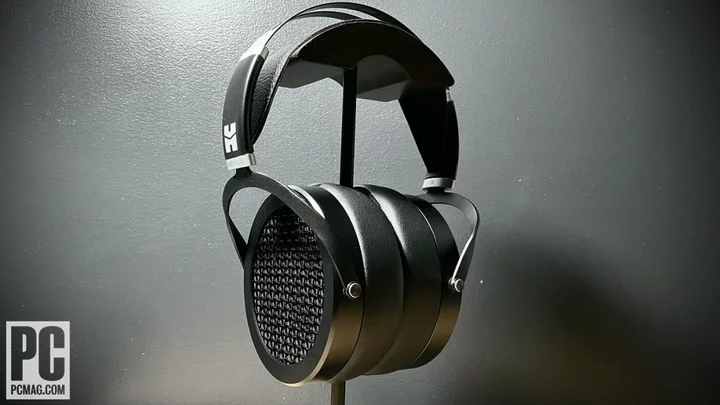The open-back HiFiMan Sundara headphones feature planar magnetic drivers that deliver clear detail. They sit at the more affordable end of HiFiMan’s lineup (and the planar magnetic category) at $299, but still deliver the crisp, transparent audio experience we've come to expect from the company. They are excellent as reference headphones for mixes or accurate listening at home, though we would prefer a wider soundstage. If you're looking for more pronounced bass response and a broader stereo image, the dynamic-driver Grado SR325x headphones ($295) are our Editors' Choice winner in this price range.
Large, Open-Back Enclosures
The Sundara headphones are available only in black, and their massive, circular, and circumaural (over-ear) earcups offer generous padding. They have a soft leather-like lining and use a technical fabric for the section that contacts your skin. The headband's fixed design might not appeal to everyone, but you can adjust the tension of the soft, weight-dispersing leather-like strap that presses against the top of your head. I found the headphones comfortable, but your experience might be different.
(Credit: Tim Gideon)As mentioned, the headphones use planar magnetic drivers. According to HiFiMan, these particular drivers are 80% thinner than those in previous models and are quicker to respond to changes in sound. They have a frequency range of 6Hz to 75kHz, with an impedance of 32 ohms. As with any open-back pair, they leak audio through the outer grilles, so they aren't ideal for crowded environments or offices. On the plus side, this style of headphones makes it easier for you to hear your surroundings while you're wearing them.
The approximately 5-foot cable is a little short. If you aren't sitting close to your sound source, small movements are likely to yank the cable free or at least pull it taut. The good news is that it's detachable, so you can swap it out for whatever cable you prefer. Grado's SR325x headphones have a slightly longer cable that measures a little over 5.5 feet, but its hardwired design is limiting.
(Credit: Tim Gideon)The Sundara headphones don't ship with any sort of protective case, stand, or tote. I would have at least liked to see a simple drawstring bag to protect against scratches and dust. You do get a quarter-inch adapter in the box, however. HiFiMan lists a couple of travel cases on its storefront, but none are available for shipping to the US as of this writing.
Like most audiophile headphones, these don't offer any extra features such as wireless listening, app compatibility, track navigation, or active noise cancellation. They are purely about sound quality.
Detailed Sound With a Subtle Low-End Response
Despite fairly typical impedance, the headphones don't get as loud as many other models we test. For reference, when I listen to lossless Apple Music audio on an iMac via a McIntosh stereo receiver, they only start to get uncomfortably loud after I max out the volumes of both the app and the receiver. Those same levels with the Grado SR325x are extremely loud, to the extent that they could potentially damage the headphones.
(Credit: Tim Gideon)On tracks with serious sub-bass, like The Knife’s “Silent Shout,” the HiFiMan headphones deliver an accurate low-frequency response. The deep lows are articulate and full, but you need to look elsewhere if you want subwoofer-like performance. For comparison, the Grado SR325x model outputs noticeably more bass depth.
The Sundara pair doesn't have any problem reproducing the sub-bass at the 34-second mark of Kendrick Lamar’s “Loyalty.” As the sub-bass synth line descends, the drivers reproduce each hit with an appreciable rumble, but never push them forward. The various vocals exhibit excellent clarity without any harshness.
Bill Callahan’s “Drover,” a track with a more varied range of frequencies, gives us a better sense of the sound signature. The drums sound natural and full, while the higher percussive hits retain plenty of detail and brightness. Callahan’s baritone vocals benefit from an ideal blend of low-mid richness and higher-mid definition. And, thankfully, the headphones don't scoop the mids. Overall, they accomplish an even, mostly flat audio signature.
(Credit: Tim Gideon)On orchestral tracks, like the opening scene from John Adams’ The Gospel According to the Other Mary, they deliver rich but subtle bass. Otherwise, I hear plenty of high-mid detail and clarity.
The headphones present Miles Davis’ “Pharaoh’s Dance,” with a good balance between the lows, mids, and highs, but the latter two frequency ranges get more attention. The percussive hits and keyboard notes come across with excellent high-frequency detail, while the drums pack a natural, pleasant thump.
Headphones for a Realistic Recreation of Music
HiFiMan's Sundara headphones succeed in their ability to reproduce detail with a strong sense of realism thanks to their planar magnetic drivers. We also like the replaceable cable, as it extends the lifespan of the headphones past that of hardwired alternatives. Compared with the similarly priced Grado SR325x, however, they offer a bit less bass depth and noticeably less soundstage. The latter means live recordings don’t sound as immersive, so we ultimately prefer the Grado pair. If you want a more studio-focused audio experience, check out the closed-back Beyerdynamic DT 700 Pro X monitors ($299), another Editors' Choice winner.









